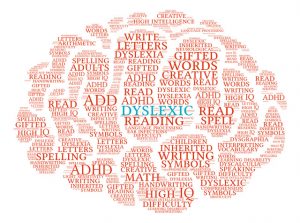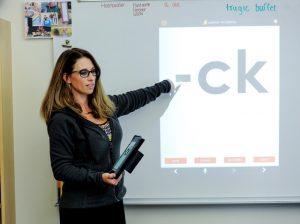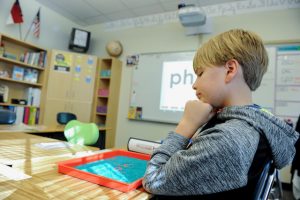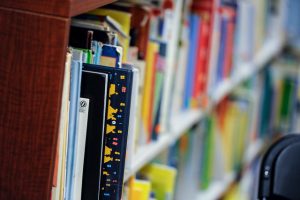By our Smarty friends at The Fletcher School
Are you confused about the meaning of dyslexia? Unsure whether it’s a catch-all term for many learning disabilities or, rather, a stand alone term for a specific learning disability? Chances are, you’re not alone. As awareness around dyslexia has grown, so has the confusion around what this diagnosis really means.
At Fletcher, our faculty have over 35 years of experience teaching students with learning differences using the Orton-Gillingham approach. Dyslexia is one of the most common learning styles we see in our classrooms. Calling on the expertise of our certified Orton-Gillingham (OG) Fellow, Joanie Gerken, we’ve provided some key facts about Dyslexia to help you better understand this popular term:
Dyslexia falls under the category of a Specific Learning Disability (SLD) as defined in the DSM-5 – a diagnostic tool published by the American Psychiatric Association (APA).
DSM-5 defines a SLD as a Neurodevelopmental Disorder that impedes a person’s ability to learn or use specific foundational academic skills, such as reading, writing, or math.
Dyslexia Defined:
As used by the International Dyslexia Association (IDA) dyslexia is “a specific learning disability that is neurobiological in origin. It is characterized by difficulties with accurate and/or fluent word recognition and by poor spelling and decoding abilities. These difficulties typically result from a deficit in the phonological component of language that is often unexpected in relation to other cognitive abilities and the provision of effective classroom instruction. Secondary consequences may include problems in reading comprehension and reduced reading experience that can impede growth of vocabulary and background knowledge.”
Put simply, Dyslexia is a SLD in reading.
How Is Dyslexia Different (and Similar) from Other SLDs?
Dyslexia is often misunderstood as a general or ‘catch-all’ term for a range of learning disabilities, however, the diagnosis has a distinct set of characteristics that sets it apart from other SLDs. While some of these characteristics do in fact overlap or even occur with the similar SLD dysgraphia, they’re not the same thing. Dyslexia primarily affects reading whereas dysgraphia primarily affects the physical act of writing.
According to Understood.org, a dyslexic reader will display the following characteristics:
– Difficulty associating sounds with letters and letters with sounds (decoding)
– Confusion when pronouncing words and phrases, such as saying “mawn lower” instead of “lawn mower”
– Difficulty reading aloud with the proper tone and grouping words and phrases together appropriately
– Difficulty “sounding out” unfamiliar words
– Trouble writing or copying letters, numbers and symbols in the correct order
– Trouble rhyming
OG Fellow Joanie Gerken shares these additional signs and symptoms of dyslexia:
– Mixed laterality – lack of dominance in eye, hand and foot preference
– Limited internal timing
– Poor motor control – apraxia
– Poor handwriting
– Direction confusion -confuses front/back, left/right, before/after
– Familial – similar learning problems in other family members
– Extreme difficulty sequencing
– Letter reversals or word/syllable reversals
– Slow or delayed speech development
– Poor oral reading
– Poor spelling
– Inability to copy; trouble getting ideas on paper
– Short attention span
Based on these characteristics, it’s clear that dyslexia primarily manifests through difficulty with reading — the processing of words. Yet, the list of characteristics also includes writing, spelling and speaking. It’s important to note that dyslexia expresses itself in different ways depending on the person. For example, Dyslexia shares characteristics with dysgraphia when a child especially struggles with orthographic decoding — the ability to sound out letters and words by learning how symbols (letters) are associated with certain sounds. When this is the case, the child will often struggle with handwriting.
The Dyslexic Brain is Different:
To help us understand the ‘cause’ of dyslexia and how it manifests differently from person to person, Gerken explains the dyslexic brain:
As with all SLDs (dyslexia, dysgraphia (writing), dyscalculia (math), auditory processing disorder, etc.), dyslexia is a brain-based condition.
People can have trouble reading for all kinds of reasons, but usually, these are due to external factors such as a bad teacher. In a person with Dyslexia, their brain actually functions differently — it reads differently than a typical brain. In a dyslexic brain, the neurons that would normally fire when attempting to read and process language are not firing or working in the way they typically do. This is due to differing neurological pathways in a dyslexic brain.
In a typical brain, reading takes place in the left hemisphere — this is where the brain decodes words to process and understand language. A dyslexic brain is actually a different type of brain — it processes information and words in the right hemisphere — the more creative (rather than logical) side of the brain. (This is why people with dyslexia are often seen as being more creative, out-of-the-box thinkers.)
It is because of this key difference in neurological processing that children with dyslexia struggle with word recognition and matching letters with sounds and symbols (decoding). For example, a child with dyslexia may not remember that the letter “b” makes the “buh” sound. And when this child is getting ready to read, he/she isn’t using the left hemisphere to decode words piece by piece to determine their meaning, rather, they’re using their right hemisphere which focuses on the context that surround a particular word in an effort to determine its meaning. You’ll find that a lot of children with dyslexia will try and guess at words using context, or even look at pieces within a word to help them picture what that word might be.
For some dyslexic children the difficulty is primarily with the decoding piece of language processing. Once you fix the issues with decoding, they get the main idea or “rules” of language, and then they can read.
So, dyslexia can affect the process of taking in information (decoding), but it can also affect the ability to retrieve information. For these children, it might be that they can actually read better than they can spell due to problems with recall. The dyslexia, then, shows up more in their written expression, especially when you get to hidden sounds in words. For example, it is difficult to remember that the word “right” has a silent “gh” and there isn’t an “e” on the end.
Why the Orton-Gillingham Method of Teaching Works for Dyslexia
Proven especially effective for children with Specific Learning Disabilities (SLD), the Orton-Gillingham (OG) methodology utilizes phonetics and multisensory teaching methods which cater to visual, auditory and kinesthetic learning styles. Instruction begins by focusing on the structure of language and gradually moves towards reading multisyllabic words, sentences, and passages. Through this approach, teachers provide students with immediate feedback and a predictable sequence that integrates reading, writing, and spelling.
This approach is unique in that it is both prescriptive and systematic — it’s about figuring out where the child fits in the learning sequence. It’s literally based on a child’s unique needs. Through this approach, educators are able to capitalize on an individual student’s dominant learning modality while delivering instruction that will strengthen the remaining learning pathways. Multi-sensory instruction helps a dyslexic child take in and recall more easily due to the variety of channels that information is processed through.
While it can be very hard for those diagnosed with dyslexia to achieve a level of reading that is automatic, or with little effort, the OG method has been proven to aid in significant progress.
For Further Information:
www.ldaamerica.org
http://dyslexiaida.org/
https://www.understood.org/en
About Joanie Gerken, Fellow/AOGPE
Joanie Gerken is a Fellow with the Academy of Orton-Gillingham Practitioners and Educators. Joanie has worked in the field of learning differences  for over 45 years, teaching math and reading, as well as graduate level courses and seminars on multisensory teaching strategies and the Orton-Gillingham approach. She did her undergraduate studies at Clemson University and received her Masters in Special Education at the College of Charleston. In 2012, she received the Leadership and Literacy Award from the International Dyslexia Association.
for over 45 years, teaching math and reading, as well as graduate level courses and seminars on multisensory teaching strategies and the Orton-Gillingham approach. She did her undergraduate studies at Clemson University and received her Masters in Special Education at the College of Charleston. In 2012, she received the Leadership and Literacy Award from the International Dyslexia Association.
In her role as a staff member at The Fletcher School, Joanie provides training and support for our teachers. Her expertise in interpreting psychological educational evaluations to determine individual learning needs is a valuable resource to faculty and staff. In addition to teaching Orton-Gillingham courses through The Rankin Institute, Joanie presents a workshop for parents and community members on reading disorders.
Joanie resides in Charleston, SC and is on campus two weeks a month. She also serves as a Fellow at the Swift School in Atlanta, GA.

The Fletcher School
5800 Sardis Road
Charlotte, NC 28270
704-365-4658
www.thefletcherschool.org
Facebook: @FletcherFalcons
Twitter: @FletcherFalcons
Instagram: @fletcherfalcons






